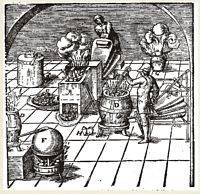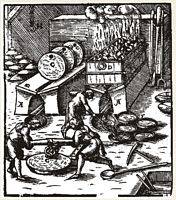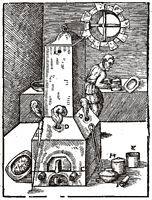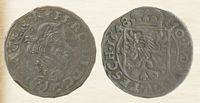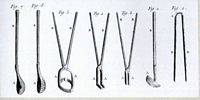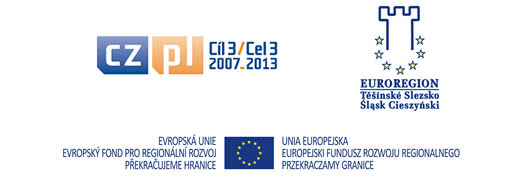The mint in Pilutek’s House
It was mentioned earlier that after Rundt's death, Hans Loss became the new mint master in Cieszyn under the terms of a three-year contract concluded with Elizabeth Lucretia and signed on 23rd April 1647. It differed only in certain details from the previous one. It is interesting to note that the Princess pledged to supply the mint master with wood and coal, although Loss had to organise the delivery of the latter at his own expense. A clause in the contract reads that in order to mint coins Loss was allowed to live and work in a building in Cieszyn belonging to the Princess, called Pilutek’s House. However, it still does not resolve the problem of where coins were minted in Cieszyn i.e. where precisely the Cieszyn mint was located.
It is commonly thought that the Cieszyn mint had ”always” been located at 46 Mennicza Street in the building known as Bludowski’s House (which now houses the Cieszyn Historical Library). It is undoubtedly true that the mint did function there for some time and the name of the street derives from that fact (Mennicza is an adjective of mennica i.e. mint ). However, Bludowski’s House was built in 1719 while the building which was once used for minting was located lower down, in an outbuilding behind it. Most important of all though, the mint did not function there permanently, was not ”always” located there at all. In fact it is not known where individual mint masters carried out their work before 1643. No municipal documents refer to any specific building as a mint. Neither do the contracts described above, which are concerned with the lease of the right to mint coins, but not premises. Frequent pauses in minting in Cieszyn suggest that minting mostly took place in a variety of locations, mainly in private buildings at the mint masters’ disposal, or in the Cieszyn castle. However, in such a case the prince would not have had to order the town authorities not to disturb the mint masters in their work. It is probable that the mint started functioning permanently in one location during the period of Frederick William's rule, making use of the large quantity of equipment seized in 1626. In the contract of 1647 for the first time we come across information relating to the possible location of a mint, which seems to suggest that the house was owned by the Pilutek family. But the building did not belong to the Princess until 1643, therefore the princely mint could not have functioned there earlier unless the building had been leased.
The Pilutek family played a minor – but dramatic – role in the history of Cieszyn, but the building itself had been built earlier. The owners of the building were typically members of the gentry since they were particularly interested in acquiring houses in the town centre, which in the Middle Ages was situated in the area around the parish church (now Theatre Square). In the middle of the 16th century there were two adjacent houses owned by the influential Rudzki family in the vicinity of the church. One belonged to Erasmus Rudzki, and the other to Wenceslas Rudzki, the chancellor of the Cieszyn Duchy. The latter house was most probably once lived in by Father Gregorius Czaidych. After his death in 1547 Prince Wenceslas Adam gave the house to Wenceslas Rudzki, one of the most influential people at the princely court. It is possible that the building lived in by Father Czaidych belonged to the Cieszyn Parish before the introduction of the Reformation to the Cieszyn Duchy. Nonetheless, a hundred years later the Dean of Cieszyn, Adam Fritsch, demanded the return of Pilutek’s House as property belonging to St. Mary Magdalene’s church.
In the first half of the 17th century, as a result of family connections with the noble Rudzki family of Rudze, the Pilutek family came into possession of the building. The Piluteks (their surname is also recorded as Bilutek, Bylotek or Pilotka in various documents) came from Fryątát, which is mentioned for the first time with reference to Jacob Pilutek and his wife Magdalene in 1599. Magdalene was a noblewoman, the daughter of Sigismund Rudzki of Rudze whereas Pilutek was most likely a burgher but held a responsible and very lucrative post as imperial tax collector. He later moved to Cieszyn where as a so called factor he traded copper for the Fugger family, bankers from Augsburg, from 1621. He died around 1626. It is possible that towards the end of his life Jacob Pilutek was raised to the gentry (like several other men holding the post of imperial tax collectors in the Duchy of Cieszyn in the 17th century). Be that as it may, his heir, Wenceslas Pilutek, considered himself a nobleman. He was known for his very self-important manner, and hobnobbed with the nobility. In 1634 he took part in the so called Freiberg Uprising against the Habsburgs in Opava with other Cieszyn noblemen. He was arrested, but came out of the affair with his reputation untarnished, even becoming an advisor to the Cieszyn Princess Elizabeth Lucretia. However, in 1643 he fell out of favour with the Princess, although the reason remains unknown. The anonymous Skoczowskie Osobliwości (Skoczów Curiosities) claimed that Pilutek dared to write and speak out against the Princess rather too much but without supporting evidence. Neither imperial safe-conduct nor a refuge in the Dominican monastery in Cieszyn helped him. He was tried by princely officials whose verdict Elizabeth Lucretia ordered to be confirmed by three municipal courts; in Cieszyn, Skoczów and most probably in Fryątát. The judges sentenced Pilutek to death by quartering but Elizabeth Lucretia showed mercy and commuted the sentence to beheading. The execution took place in November 1643 and the Princess made it her business to confiscate his possessions. In this way the building which had previously been owned by the Rudzki family and then by their relatives the Piluteks finally fell into the hands of the Princess, who decided that it should become a mint. For a long period, that is until the second half of the 18th century, the building was referred to either as ”the Old Mint” or ”Pilutek’s House”. The Pilutek family tried unsuccessfully to regain it after the death of the Princess.
The important fact is that the Cieszyn mint functioned in Pilutek’s House for the next decade. Whether Dietrich Rundt minted coins there is not certain but Hans Loss without doubt set up his workshop there when he became the Cieszyn mint master in 1647. He generally continued his predecessor’s work by striking only kreutzers (1647-49) and 3 kreutzer coins (1647-49), with the bust of Ferdinand III and his imperial titles on the obverse, and the Cieszyn eagle on the reverse.
What is more, the nominal mint master of Skoczów carried out his work in the same building. For when Loss was appointed mint master in Cieszyn his post in Skoczów was taken up in September 1648 by Ludwig Bremen (also known as Brohon) for the period of one year. Owing to opposition from some quarters, most probably from townspeople, the Princess permitted the new mint master to set up his mint workshop in his house in Cieszyn. She also exempt Bremen’s house from the requirement of billeting troops and other military obligations. Indeed, soon his workshop, at least in May 1649, was located in Pilutek’s House, too. Thus all the coins issued by him with the mintmark of the Skoczów mint were in fact struck in Cieszyn. Between 1648 and 1649 Ludwig Bremen minted the same coinage as Loss; kreutzers and 3 kreutzer coins. Dies used by both mint masters were designed by the same person – Christoph Berger, the Cieszyn goldsmith. All this information was gleaned from more extensive records of an investigation carried out by the imperial authorities into individuals engaged in minting coin in Cieszyn in 1649.

